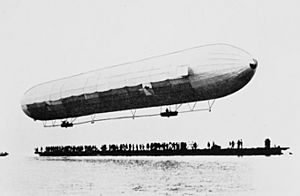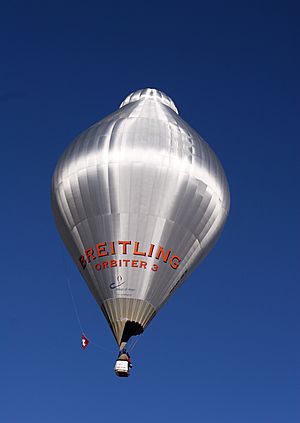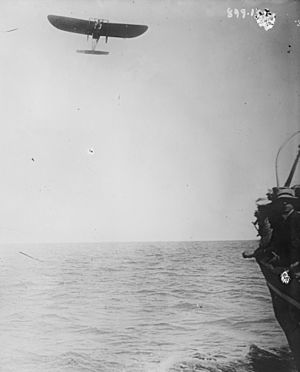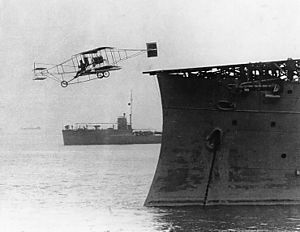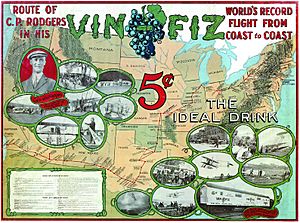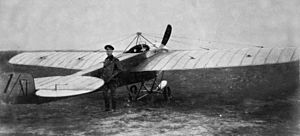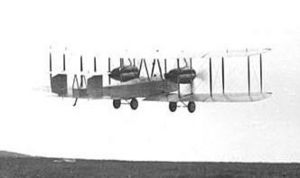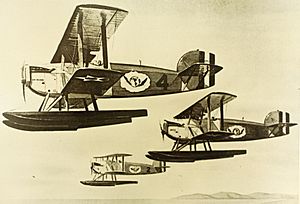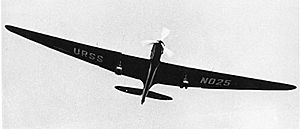List of firsts in aviation facts for kids
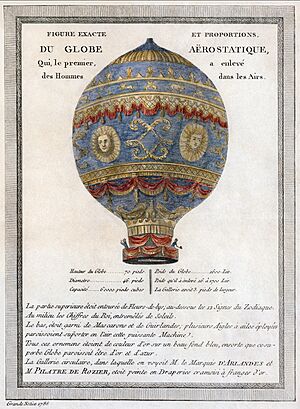
Aviation is all about flying! This article shares some of the most important "firsts" in the history of flight. From early attempts to glide, to the first hot air balloons, and then to amazing airplanes and rockets, people have always dreamed of soaring through the sky.
Contents
Early Attempts to Fly
For a long time, people tried to fly using different ideas. Here are some of the earliest stories:
- In 559 A.D., a Chinese prisoner named Yuan Huangtou was forced to launch himself from a tower using a large kite. He survived the flight, but sadly, he was later executed.
- In the 9th century, Abbas ibn Firnas from Spain tried to glide with wings covered in feathers. He flew a short distance from a tower but was hurt when he landed.
- In the early 11th century, an English monk named Eilmer of Malmesbury also tried gliding with wings. He flew a short way but broke his legs when he landed.
- Around 1509, a Scottish abbot named John Damian might have tried to fly from Stirling Castle. This story comes from funny poems, so we're not sure if it really happened.
- Between 1630 and 1632, a Turkish person named Hezarfen Ahmed Çelebi is said to have glided across the Bosphorus strait in Istanbul.
- In 1633, his brother Lagari Hasan Çelebi might have flown using a rocket powered by gunpowder!
It's hard to prove these old stories. The first flight that we know for sure happened was in 1783, when Jean-François Pilâtre de Rozier flew in a Montgolfier balloon.
First Flights in Balloons (Lighter than Air)
Balloons were the first successful way for humans to fly! They are called "lighter than air" aircraft because they float using hot air or light gases.
Early Balloon Adventures
- First animals to fly in a balloon: On September 19, 1783, the Montgolfier brothers sent a sheep named Montauciel, a duck, and a rooster on a balloon ride.
- First manned flight: Étienne Montgolfier was the first person to go up in a Montgolfier hot air balloon on October 15, 1783. The balloon was tied to the ground.
- First manned free flight: Jean-François Pilâtre de Rozier and Marquis d'Arlandes made the first untethered (not tied down) flight in a Montgolfier hot air balloon over Paris on November 21, 1783.
- First gas balloon flight: Professor Jacques Charles and Nicolas-Louis Robert flew in a balloon filled with hydrogen gas on December 1, 1783. Hydrogen is much lighter than air.
- First women to fly: Several women, including the Marchioness and Countess of Montalembert, flew in a tethered balloon over Paris on May 20, 1784.
- First woman in free flight: Élisabeth Thible flew over Lyon, France, on June 4, 1784, even singing songs to entertain the King of Sweden!
- First flight across the English Channel: Jean-Pierre Blanchard and John Jeffries made this famous crossing in a balloon on January 7, 1785.
Balloon Safety and Records
- First aviation disaster: On May 10, 1785, a hot air balloon caused a fire in Tullamore, Ireland, burning down about 100 houses.
- First known deaths in an air crash: Jean-François Pilâtre de Rozier and Pierre Romain died when their balloon crashed on June 15, 1785.
- First jump from a balloon with a parachute: Jean-Pierre Blanchard used a parachute to escape his balloon in 1793 when it broke.
- First successful parachute jump from a balloon: Andre Jacques Garnerin made a successful jump in Paris in 1797.
- First woman to jump from a balloon with a parachute: Jeanne Geneviève Labrosse jumped from about 900 meters (2,950 feet) on October 12, 1799.
- First woman to pilot her own balloon: Sophie Blanchard flew solo on August 18, 1805.
- First woman killed in an aviation accident: Sophie Blanchard died when her hydrogen balloon caught fire on July 6, 1819.
Modern Airships and Balloons
- First successful steerable powered balloon (airship): Henri Giffard developed and flew the Giffard dirigible on September 24, 1852.
- First flight of a rigid airship: The famous Zeppelin LZ 1 flew from Lake Constance on July 2, 1900.
- First woman to pilot a powered aircraft: Rose Isabel Spencer flew an airship on July 14, 1902.
- First trans-Atlantic rigid airship flight: The R34 flew from Scotland to New York from July 2 to July 6, 1919.
- First people to reach the stratosphere: Auguste Piccard and Paul Kipfer went up to 15,545 meters (51,000 feet) in a hydrogen balloon on May 27, 1931.
- First crossing of the Atlantic by balloon: Ben Abruzzo, Maxie Anderson, and Larry Newman crossed in the Double Eagle II on August 17, 1978.
- First balloon flight on another planet: The Soviet Vega 1 Balloon flew in the skies above Venus in June 1985. This was the first human-made flight of any kind on another planet!
- First non-stop balloon flight around the Earth: Bertrand Piccard and Brian Jones flew the Breitling Orbiter 3 around the world in 19 days, from March 1 to March 21, 1999.
- First solo non-stop balloon flight around the Earth: Steve Fossett flew the Spirit of Freedom around the globe by himself from June 19 to July 3, 2002.
First Flights in Airplanes (Heavier than Air)
Airplanes are called "heavier than air" aircraft because they use wings to create lift and engines to move forward.
Pioneer Era (1853–1914)
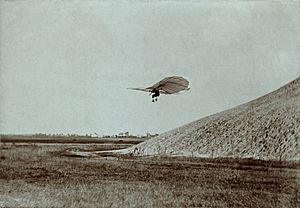
- First manned glider flight: An unnamed boy flew in a glider launched by George Cayley in 1853.
- First controlled manned glider flight: Otto Lilienthal flew his own glider in 1891.
- First controlled, sustained flight in a powered airplane: The most famous first! Orville Wright flew the Wright Flyer on December 17, 1903, covering about 37 meters (120 feet). His brother Wilbur watched.

- First circular flight by a powered airplane: Wilbur Wright flew in a circle on September 20, 1904.
- First flight of an aircraft with pneumatic tires: Traian Vuia's Vuia 1 flew on March 18, 1906, with air-filled tires.
- First airplane passenger: Léon Delagrange flew with pilot Henri Farman on March 29, 1908.
- First use of modern flight controls: The Blériot VIII used a joystick for pitch and roll, and a foot-bar for steering, in April 1908.
- First person to die in a powered airplane crash: Thomas Etholen Selfridge was a passenger when an aircraft flown by Orville Wright crashed on September 17, 1908.
- First official pilot's license: Licence number 1 was given to Louis Blériot on January 7, 1909.
- First airplane flight across the English Channel: Louis Blériot completed this flight in his Blériot XI on July 25, 1909, winning a big prize!
- First animal to fly on an airplane: John Moore-Brabazon took a pig named Icarus II for a ride on November 4, 1909, as a joke!
- First woman to earn a pilot license: Raymonde de Laroche received hers on March 8, 1910.
- First documented seaplane flight: Henri Fabre flew his Le Canard (the duck) from the water on March 28, 1910.
- First aircraft flight simulator: Built by Antoinette in May 1910 to teach pilots.
- First airborne radio communications: Frederick Walker Baldwin and Douglas McCurdy sent a Morse code message from a plane on August 27, 1910.
- First shipboard take-off and landing by an airplane: Eugene Burton Ely took off from a platform on the USS Birmingham on November 14, 1910, and later landed on the USS Pennsylvania on January 11, 1911.
- First non-stop flight from London to Paris: Pierre Prier flew this route on April 12, 1911.
- First woman to die in a powered airplane crash: Denise Moore fell from a plane on July 21, 1911.
- First transcontinental flight across North America: Calbraith Perry Rodgers flew his Vin Fiz Flyer across the United States from September 17 to December 10, 1911, with many stops.
- First parachute jump from an airplane: Grant Morton jumped from a plane in 1911.
- First woman to fly across the English Channel: Harriet Quimby flew from Dover to Hardelot-Plage on April 16, 1912.
- First take-off by an airplane from a moving ship: Commander Charles R. Samson took off from HMS Hibernia on May 9, 1912.
- First all-metal aircraft to fly: The Reissner Canard flew on May 23, 1912.
- First four-engine aircraft to fly: The Russian Bolshoi Baltiskiy developed by Igor Sikorsky flew on May 10, 1913.
- First loop: Pyotr Nesterov looped a Nieuport IV on September 9, 1913.
- First flight across the Mediterranean: Roland Garros flew from France to Tunisia on September 23, 1913.
- First scheduled commercial airplane flight: Tony Jannus flew a Benoist XIV flying-boat with a paying passenger from St. Petersburg to Tampa, Florida, on January 1, 1914.
Practical Flight (1914–1938)
This era saw airplanes become more reliable and useful.
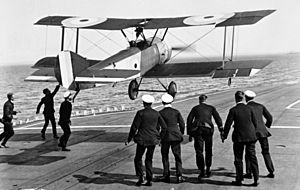
- First aircraft intentionally downed by another aircraft: Pyotr Nesterov rammed an Austrian plane with his on September 7, 1914. Both planes were destroyed.
- First aircraft to shoot down another aircraft: A French Voisin III shot down a German Aviatik B.II on October 5, 1914.
- First female military pilot: Eugenie Mikhailovna Shakhovskaya became a reconnaissance pilot for Russia on November 19, 1914.
- First aerial victory for a fighter with a fixed forward-firing machine gun: Roland Garros used a special propeller with steel wedges to deflect bullets, downing three German planes in March 1915.
- First aerial victory for a fighter with a synchronized machine gun: Kurt Wintgens used a machine gun that fired between the propeller blades on July 1, 1915.
- First sinking of a ship with an aerial torpedo: Charles Edmonds sank a Turkish supply ship with a torpedo from his plane on August 12, 1915.
- First medical evacuation (medevac) by air: Louis Paulhan evacuated an ill person from the Serbian front in 1915.
- First black military pilot: Ahmet Ali Çelikten served in the Ottoman Aviation Squadrons from 1914 or 1915.
- First landing by an airplane on a moving ship: Edwin Harris Dunning landed a Sopwith Pup on HMS Furious on August 2, 1917.
- First flight by an airplane across the Andes: Luis Candelaria flew from Argentina to Chile on April 13, 1918.
- First attack by aircraft launched from an aircraft carrier: Sopwith Camels launched from HMS Furious destroyed Zeppelins on July 19, 1918.
- First transatlantic flight: Albert Cushing Read and his crew flew a US Navy Curtiss NC-4 flying boat from New York to England, with stops, from May 8–31, 1919.
- First non–stop transatlantic flight: John Alcock and Arthur Brown flew a Vickers Vimy from Newfoundland to Ireland on June 14–15, 1919.
- First transatlantic stowaways: William Ballantyne and his cat, Wopsie, hid aboard the R34 airship for a flight from the UK to New York in July 1919.
- First flight across the Andes by a woman: Adrienne Bolland flew from Argentina to Chile on April 1, 1921.
- First African–American or Native American or Black person to obtain an international pilot's license: Bessie Coleman on June 15, 1921.
- First capital ship sunk by aircraft: Bombers sank the captured German battleship Ostfriesland on July 21, 1921.
- First aerial refuelling: Done by Wesley "Wes" May, Frank Hawks and Earl Daugherty using a Lincoln Standard biplane and a Curtiss Jenny.
- First aerial refueling with a fuel line: A US Army Air Service plane refuelled another in mid-air on June 27, 1923.
- First aerial circumnavigation (around the world): Pilots Lowell H. Smith, Erik H. Nelson and John Harding Jr., in Douglas World Cruisers, flew around the world from April 6 to September 28, 1924.
- First solo non-stop New York to Paris transatlantic flight: Charles Lindbergh, flying the Spirit of St. Louis, made the 33-hour journey on May 20–21, 1927, winning the Orteig Prize.

- First outside loop: Jimmy Doolittle performed this stunt on May 25, 1927.
- First female airline pilot: Marga von Etzdorf was hired by Lufthansa in 1927.
- First east–west non–stop transatlantic crossing: The Bremen flew from Ireland to Quebec from April 12–13, 1928.
- First transpacific flight (US to Australia): Charles Kingsford Smith and crew flew the Southern Cross from California to Australia between May 31 and June 9, 1928.
- First rocket-powered aircraft to fly: The Lippisch Ente flew on June 11, 1928, using solid fuel rockets.
- First woman to fly across the Atlantic (as passenger): Amelia Earhart was a passenger on a flight from Newfoundland to Wales on June 17, 1928.
- First aircraft to be flown only on instruments (blind flying): Jimmy Doolittle flew a plane using only instruments on September 24, 1929.
- First flight over the South Pole: Richard E. Byrd and his crew flew over the South Pole in the "Floyd Bennett" on November 29, 1929.
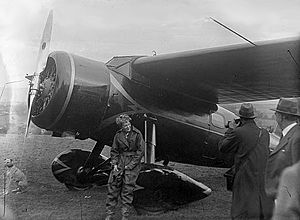
- First nonstop flight across the Pacific: Clyde Pangborn and Hugh Herndon flew from Japan to Washington on October 4–5, 1931.
- First female pilot to fly solo across the Atlantic Ocean: Amelia Earhart, in a Lockheed Vega 5B, flew from Newfoundland to Ireland on May 20, 1932.
- First successful helicopter with a single main lifting rotor: The TsAGI-1EA flew to a record height of 605 meters (1,985 feet) on August 14, 1932.
- First flight over Mount Everest: Lord Clydesdale and David McIntyre flew over Everest on April 3, 1933.
- First scheduled commercial trans-Pacific passenger service: Pan-American began regular passenger service from San Francisco to Manila on October 21, 1936.
- First trans–polar flight: A Tupolev ANT-25RD flew from Moscow to Vancouver, Washington, crossing the Arctic from June 18–20, 1937.
- First flight of a commercial aircraft with a pressurized cabin: The Boeing 307 Stratoliner flew on December 31, 1938.
Jet Age (1939–Present)
The invention of the jet engine changed aviation forever, making planes much faster.
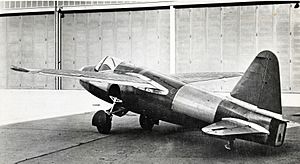
- First flight by a liquid-fueled rocket-powered aircraft: The Heinkel He 176 flew on June 20, 1939.
- First scheduled commercial transatlantic passenger service: Pan American Boeing 314 Clipper flying boats began flights between New York City and Marseille, France, on June 28, 1939.
- First flight by a turbojet-powered aircraft: The Heinkel He 178 flew on August 27, 1939.
- First operational use of a military assault glider: The German Luftwaffe used gliders to capture a fort and bridges on May 10, 1940.
- First capital ships sunk by aircraft while underway: Japanese planes sank two British battleships, HMS Repulse and HMS Prince of Wales, on December 10, 1941.
- First purpose-built jet bomber to fly: The Arado Ar 234 made its first flight on July 30, 1943.
- First rocket-powered aircraft used in combat: The Messerschmitt Me 163B Komet was used in combat on May 13, 1944.
- First jet fighter used in combat: A Messerschmitt Me 262 jet fighter attacked an RAF plane on July 26, 1944.
- First jet on jet aerial victory: A Gloster Meteor shot down a V-1 flying bomb (a type of cruise missile) on August 4, 1944.
- First aircraft to use a nuclear weapon: The USAAF Boeing B-29 Superfortress "Enola Gay" dropped the "Little Boy" bomb on Hiroshima, Japan, on August 6, 1945.
- First turboprop powered aircraft to fly: A modified Gloster Meteor flew with turbine engines driving propellers on September 20, 1945.
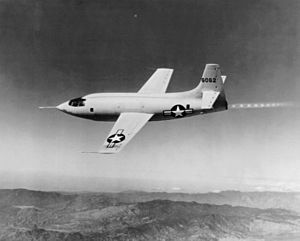
- First documented supersonic flight: Chuck Yeager flew faster than the speed of sound in a Bell X-1 on October 14, 1947.
- First flight by a jet transport: A Vickers VC.1 Viking flew on April 6, 1948.
- First nonstop around-the-world flight: Captain James Gallagher and his crew refuelled their Boeing B-50 Superfortress Lucky Lady II four times to fly around the world from February 26 to March 2, 1949.
- First jet on manned jet aerial victory: A Grumman F9F Panther shot down a MiG-15 on November 9, 1950.
- First aircraft to exceed Mach 2: Scott Crossfield flew at twice the speed of sound in a Douglas D-558-2 Skyrocket on November 20, 1953.
- First aircraft shot down with a Surface-to-Air Missile (SAM): A Taiwanese plane was hit by three SA-2 missiles over China on October 7, 1959.
- First manned Jetpack flights: Engineer Wendell Moore made the first flight in February 1961.
- First solo circumnavigation by a woman: Jerrie Mock flew around the world in her Cessna 180 Skywagon, returning to Ohio on May 17, 1964.
- First scheduled supersonic passenger flights: Concorde SSTs began flights from London and Paris on January 21, 1976.
- First circumnavigation by helicopter: H. Ross Perot, Jr. and Jay Coburn flew around the world in a Bell 206 from September 1 to 30, 1982.
- First non-stop, un-refueled flight around the Earth: Dick Rutan and Jeana Yeager flew the Rutan Voyager for over 9 days, from December 14 to 23, 1986.
- First all-female airliner crew: An American Airlines Boeing 727 was flown by an all-female crew on December 30, 1986.
- First flight by an aircraft fuelled only with hydrogen: A modified Tupolev Tu-154 airliner, the Tupolev Tu-155, flew only on hydrogen on April 15, 1988.
- First solo non-stop fixed-wing aircraft flight around the Earth: Steve Fossett flew the Virgin Atlantic GlobalFlyer around the world from February 28 to March 3, 2005.
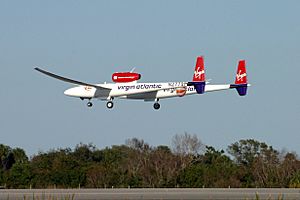
- First solo flight by an armless pilot: Jessica Cox earned her pilot's license on May 10, 2008, flying an Ercoupe using only her legs.
- First piloted overnight solar-powered flight: André Borschberg flew the Solar Impulse 1 overnight from July 7–8, 2010.
- First piloted non-stop solar-powered transatlantic flight: Bertrand Piccard flew the Solar Impulse 2 from New York City to Seville from June 20–23, 2016.
- First circumnavigation of the world by a piloted fixed-wing aircraft using only solar power: The Solar Impulse 2 completed its journey between March 2015 and July 2016.
- First powered, controlled takeoff and landing on another planet or celestial body: The NASA helicopter Ingenuity flew on Mars on April 19, 2021.
See also
- Circumnavigation
- List of circumnavigations
- Timeline of women in aviation


